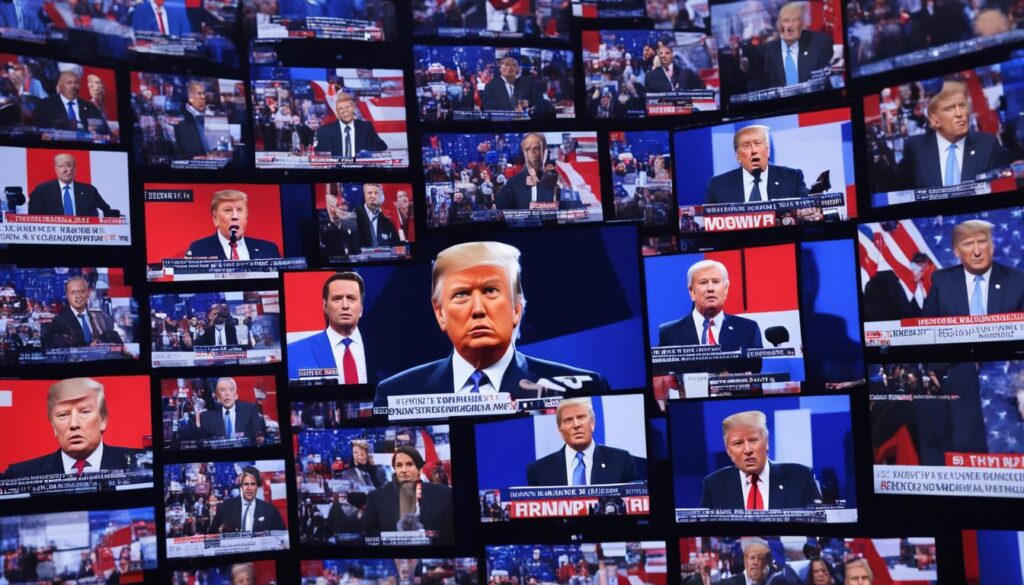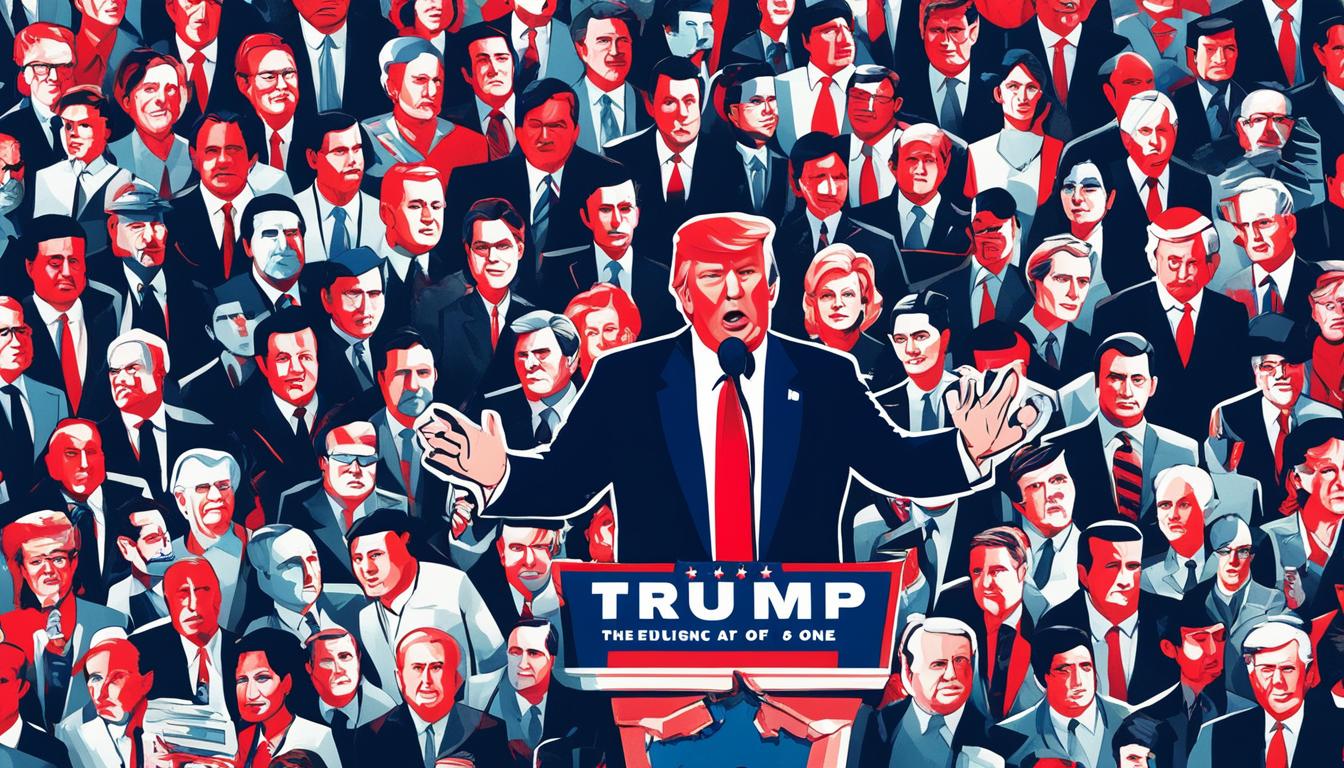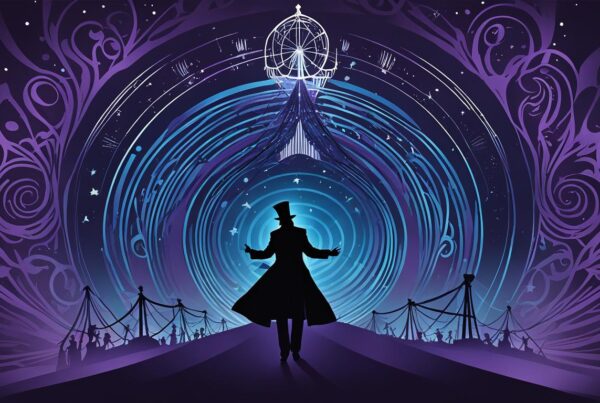Television and politics have always gone hand in hand, but no political figure has wielded the medium like Donald Trump. In “Audience of One: Television, Donald Trump, and the Fracturing of America,” James Poniewozik examines the relationship between Trump, television, and the nation’s political polarization. This audiobook review delves into Poniewozik’s thought-provoking analysis of television’s impact on politics, the rise of Donald Trump, and the fracturing of America.
Key Takeaways:
- James Poniewozik’s “Audience of One” examines the nuanced relationship between television, politics, and the rise of Donald Trump.
- The book provides valuable insights into how partisan divides and social issues are propagated by media and political messaging.
- Poniewozik’s analysis of Trump’s mastery of the television medium and its impact on the American political landscape is particularly insightful.
- The book is a thoughtful contribution to the understanding of the media-politics dynamic and its implications for the future of American democracy.
- “Audience of One” is a must-read for individuals interested in the often-overlooked role of television in shaping political discourse and public opinion.
Understanding the Impact of Television on Politics
The impact of television on politics cannot be understated. Political messaging on TV has the power to shape public perception, establish key agendas and influence the electorate. Television has changed the way people consume and engage with news and politics, and has opened up new avenues for political and social change. The role of television in shaping political discourse has set the stage for James Poniewozik’s exploration of Donald Trump’s rise to power.
Television’s influence on politics provides a powerful tool for politicians to reach their target audience at scale. The rise of televised debates and political advertising has been critical in shaping voters’ perceptions of candidates and their policies. The economics of television and the massive audiences it commands have led to an entire industry of political consultants and strategists who specialize in crafting messaging and optimizing ad buys.
The television and political discourse also shape the public’s perception of policy issues and public sentiment. Television provides a platform for political commentators to discuss and debate policy ideas, and it can be an engine of social change in its own right. Historical examples, such as the Civil Rights Movement and various student-led protests, demonstrate the power of television in shaping public opinion and driving real-world change.
Television has played a critical role in shaping the current political landscape, and its influence is unlikely to weaken anytime soon. Viewing habits may change and audiences may become more fragmented, but the need for political messaging on TV will remain paramount. In the following sections, we will explore how Poniewozik examines the fracturing of America and the role of Donald Trump in shaping this dynamic. We will analyze the media landscape during the Trump era and discuss the implications for the future of television and politics.
Exploring the Fracturing of America
James Poniewozik’s “Audience of One” delves into the deep divisions within American society and the political landscape. The nation’s political divide has led to a fractured society where the left and right hold opposing views that have become increasingly polarized over time. These opposing views have created a sense of tribalism that has pushed the country into a series of cultural wars that have become more intense with each passing year.
The impact of this division on American politics is profound, and “Audience of One” provides an in-depth analysis of how these divisions contributed to Donald Trump’s ascension. The book explores the ways in which Trump used this deep divide to his advantage, tapping into the fear and anger of voters to gain support and shape the narrative around his presidency.
The Role of Donald Trump in Television and Politics
Donald Trump’s career as a television personality, spanning several decades, has had a significant impact on his political rise and overall presence within the media. Trump’s media presence, especially in reality television, contributed to his wide appeal and recognition, which he capitalized on during his presidential campaign.
Trump’s experience as a TV personality translated into a unique persona as a political figure, with a certain charisma and energy that resonated with many Americans. This made him an appealing candidate for a significant portion of the electorate and helped him stand out from other politicians.
Trump’s impact on politics, as a result of his background in television, cannot be understated. His proven track record of reaching a vast audience through his media appearances made him a formidable opponent, providing him with a platform from which he could articulate his vision and political messaging.
Moreover, Trump’s media strategy and mastery of the television medium enabled him to shape the public narrative around him in a manner that suited his message. He actively utilized social media to communicate with his supporters, crafting an image of himself as a strong, unconventional leader who was willing to take on the Washington establishment. This was all in line with his previous experience as a TV personality, where he honed his skills in crafting and projecting a specific image to his audience.
Trump’s Career in Television
| TV Show/Event | Years on Air |
|---|---|
| The Apprentice | 2004-2015 |
| The Celebrity Apprentice | 2008-2013 |
| Miss Universe pageant | 1996-2015 |
| WrestleMania XXIII | 2007 |
Trump’s extensive experience in television is evidenced in the above table, where he has hosted and appeared in various shows and events. These experiences provided him with opportunities to develop his public speaking and media skills, which proved to be valuable assets in his political career.
Therefore, it is clear that Trump’s background in television played a critical role in his political rise, contributing to his unique persona as a political figure and enabling him to reach a vast audience and shape the public narrative around him effectively.
Television as a Catalyst for Political Change
Television has played a significant role in shaping politics and social movements, with examples from the Civil Rights Movement to more recent events like the Women’s March and Black Lives Matter protests. The power of television as a tool for political change is undeniable – it provides a platform for voices to be heard by a wide audience, creating a sense of community and shared purpose in the process.
Furthermore, TV has been used to bring attention to important issues that might otherwise go unnoticed, facilitating public discourse and influencing decision-making at the highest levels of government. It’s no wonder that many influential political leaders have leveraged television’s power to reach a broader audience and influence public opinion.
Overall, TV’s role in political change and social movements is an important part of our history and will continue to shape our future.

Analyzing the Media Landscape in the Trump Era
The media landscape in the Trump era has been reshaped significantly, with the relationship between politics and media brought into sharp focus. The emergence of social media has amplified the reach of both political messages and media platforms, leading to an unprecedented level of scrutiny and criticism.
Journalism in the age of Trump has become increasingly polarized, with some media outlets accused of bias and others of spreading fake news. The role of the media in holding politicians accountable has become more challenging, with accusations of censorship and lack of transparency.
The impact of media on society and politics cannot be ignored, and the Trump era has shown just how vital it is to have a free and independent media. With the proliferation of 24-hour news cycles and social media platforms, the challenge of responsible and accurate reporting has never been more critical.
The Impact of Media on Politics in the Trump Era
| Positive Impact | – Increased scrutiny of political figures | – Amplified reach of political messages | – Increased transparency in government proceedings |
|---|---|---|---|
| Negative Impact | – Polarization of news outlets and journalists | – Propagation of fake news and misinformation | – Challenges in holding politicians accountable |
The media landscape in the Trump era has brought into sharp focus the interplay between media, politics, and society, highlighting the importance of responsible reporting and accurate information dissemination. The next section will discuss how Trump leveraged his media presence to great effect and how it has impacted his political career.
Trump’s Mastery of the Television Medium
In his ascent to power, Donald Trump has proved himself a master of media manipulation. By leveraging his previous experience as a television personality, he quickly established himself as a dominant force in the political landscape, and effectively cemented his brand through a well-crafted media strategy.
Central to Trump’s mastery of the television medium is his ability to effectively craft his image and shape public opinion. Through social media, he maintains control over the narrative, bypassing traditional media channels to speak directly to his base. By carefully curating his image, he has successfully projected a strong, authoritarian persona, which has helped him maintain support within his base and attract new followers.
Through the extensive media coverage he has received, Trump has also been able to create a sense of chaos and cultural resonance, which has helped to keep him in the public eye and advance his image. His media strategy has been so effective that it has enabled him to control the conversation, divert attention away from controversial issues and maintain his popular support.
Examples of Trump’s Media Manipulation
| Technique | Examples |
|---|---|
| Soundbites | Repeating phrases (e.g. “Make America Great Again”), using simple language to appeal to emotions, dominating news cycles |
| Visuals | Maintaining a consistent image, hand gestures, facial expressions (e.g. the infamous “Trump pout”), wardrobe, staging events for optimal camera angles |
| Social Media | Tweeting at all hours, using provocative language, using memes, attacking opponents, crafting a cult of personality |
| Controlling the Narrative | Attacking the media as “fake news,” dismissing criticism, dominating news cycles through incessant tweeting and press conferences, and using the media to distract from controversial issues |
Trump’s media strategy demonstrates how television and social media can be used to shape opinion, influence the electorate and maintain popular support. By effectively mastering the television medium and using it to his advantage, Trump has created an indelible impression on American politics and media.
Implications for the Future of Television and Politics
As technology and communication continue to evolve, the relationship between television and politics will undoubtedly change. It is difficult to predict what the future holds, but it is clear that the power of television to shape political discourse and influence public opinion will remain a major factor.
One potential area of change is the rise of digital media and social networking platforms, which have created new avenues for political messaging and mobilization. The expansion of media outlets and the fragmentation of audiences could also influence the way political messages are communicated and received.
However, as Poniewozik notes in “Audience of One,” television’s role in shaping political discourse is far from over. With millions of viewers tuning into news broadcasts and political events, television still has the power to shape public opinion and influence political outcomes.
It is also important to consider the impact of television on the electorate and the political process. Television has the power to make or break political candidates, and its influence is felt throughout the campaign and election cycle. As the political landscape continues to evolve, it will be essential to monitor the changing role of television and its impact on the political process.
Overall, the future of television and politics is uncertain, but one thing is clear: the relationship between the two will continue to play a significant role in shaping the political landscape for years to come.
Critiquing “Audience of One”
James Poniewozik’s “Audience of One” offers a deep analysis of the intricate relationship between television, Donald Trump, and the fracturing of America. However, as with any work, there are both strengths and weaknesses worth exploring.
Strengths
Poniewozik’s book stands out for its comprehensive analysis of the dynamic between television and politics. The book provides valuable insights into how television has shaped our political landscape and how this has impacted society as a whole. Poniewozik also effectively examines the role of Donald Trump in this dynamic, demonstrating how his extensive media exposure has contributed to his rise to power.
Furthermore, “Audience of One” is well-researched and well-documented, featuring a vast array of historical examples and contemporary events that support its arguments. The book’s prose is engaging and illuminating, making it an engrossing read for anyone interested in the intersection of television and politics.
Weaknesses
One potential weakness of “Audience of One” is that it can be overly focused on Donald Trump and his personas as a TV personality and political figure, often neglecting other contributing factors to the fracturing of American society. Additionally, the book’s conclusions can be seen as bleak, emphasizing the negative effects of television on politics without exploring potential solutions or positive outcomes.
Analysis of “Audience of One”
| Strengths | Weaknesses |
|---|---|
| Comprehensive analysis of television-politics dynamic | Overemphasis on Trump persona neglecting other factors |
| Valuable insights into societal impact | Concluding on a bleak note |
| Well-researched and well-documented | |
| Engaging and illuminating prose |
Overall, “Audience of One” has its strengths and weakness, but it still offers valuable insights into the complex relationship between television and politics. It is a thought-provoking work that encourages readers to question the role of media in our society and the implications it has for the future of our democracy.
Conclusion
In conclusion, “Audience of One” by James Poniewozik offers a captivating examination of the relationship between television and politics, particularly the impact of television on the rise of Donald Trump and the fracturing of America. Poniewozik’s work provides valuable insights into the influence of media on politics, the effects of polarization, and the future implications for the TV-politics nexus.
Throughout the audiobook, Poniewozik masterfully navigates the complex intersections of media, politics, and society, providing a thought-provoking analysis that encourages further examination and discussion. By highlighting the role of TV in shaping political discourse, Poniewozik illuminates the ways in which media can serve as a catalyst for change and, simultaneously, perpetuate social divides.
Overall, “Audience of One” is a must-read for anyone interested in the intersection of media and politics, or for those looking to gain a deeper understanding of the current political climate. Poniewozik’s work is an important contribution to the ongoing conversation about the impact of media on our society and political landscape, and a timely reminder of the power and influence of television in our lives.



